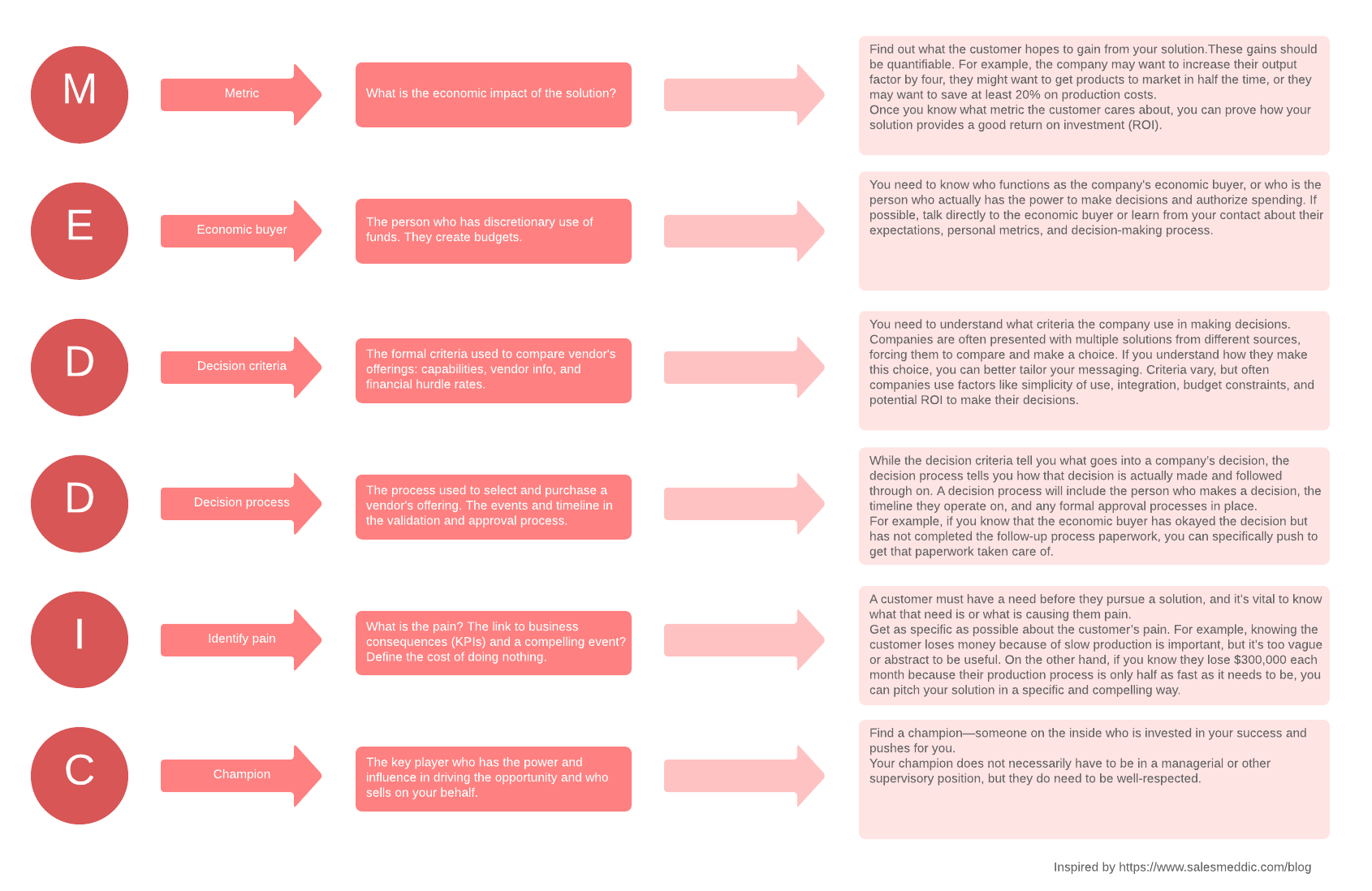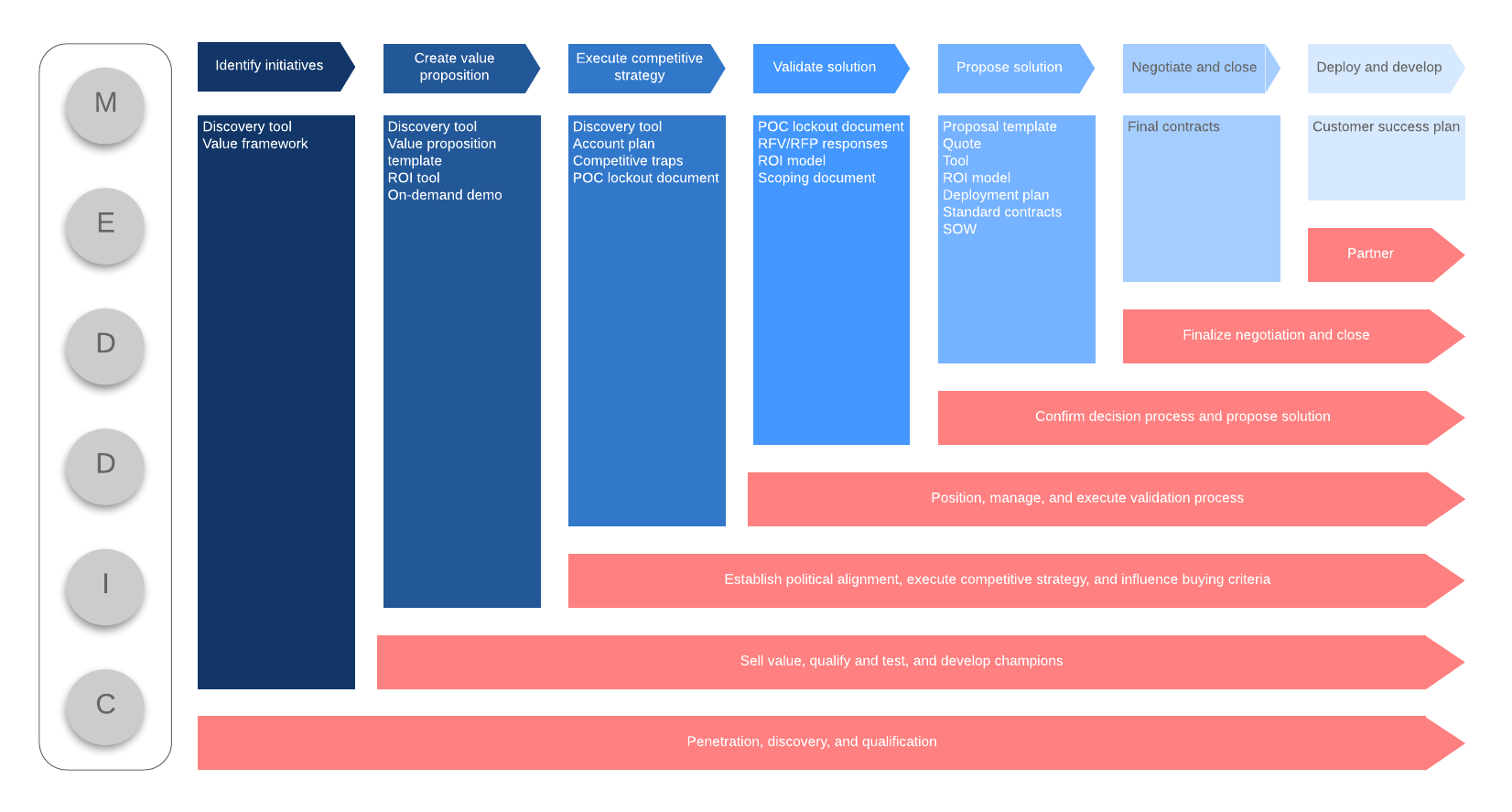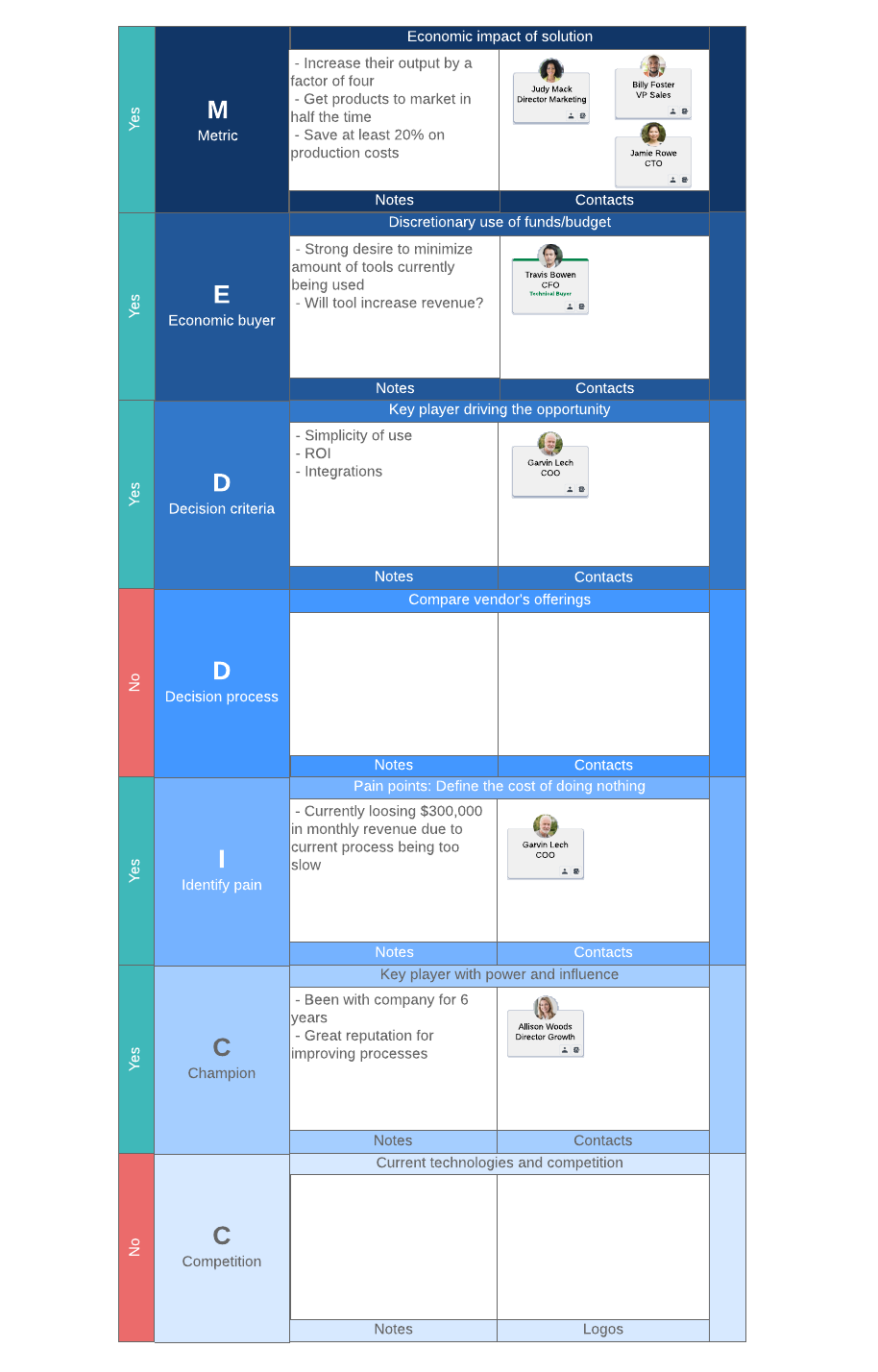What is the MEDDIC sales process?
MEDDIC is an acronym that stands for Metrics, Economic buyer, Decision criteria, Decision process, Identify pain, and Champion. This process emphasizes better customer qualification—in other words, determining whether or not you should expend effort getting a customer into your sales funnel.
Are you failing to consistently close sales? Despite what some people might tell you, the problem may not be your salesmanship or your pitch—it could be the customers you’re selling to.
The MEDDIC sales process helps you better understand and qualify your audience. You’ll know you’re selling to the right people in the right way, making it easier to close sales. This article will show you how.

What is the MEDDIC sales process?
MEDDIC Definition: The MEDDIC sales process is a B2B sales methodology first developed in the 1990s by Jack Napoli and Dick Dunkel at PTC. Using the MEDDIC framework, they increased sales from $300 million to $1 billion in four years. What sets MEDDIC apart from other sales methodologies is that the process emphasizes better customer qualification—in other words, determining whether or not you should expend effort getting a customer into your sales funnel. Advocates of the MEDDIC sales methodology argue that pitching to better-qualified customers results in a higher closing rate, thereby increasing sales success (it certainly worked for Napoli and Dunkel).
So how does it work?
MEDDIC is an acronym that stands for Metrics, Economic buyer, Decision criteria, Decision process, Identify pain, and Champion—the six concurrent steps used to qualify customers in the MEDDIC sales process.
Metrics
First, find out what the customer hopes to gain from your solution. These gains should be quantifiable. For example, the company may want to increase their output by a factor of four, they might want to get products to market in half the time, or they may want to save at least 20% on production costs.
These metrics enable you to describe the economic benefits of your solution. Once you know what metrics the customer cares about, you can prove how your solution provides a good return on investment (ROI). If you justify your solution from an economic standpoint, you’ll be one step closer to closing your sale.
Economic buyer
You need to know who functions as the company’s economic buyer, or the person who actually has the power to make decisions and authorize spending. Often, you should be talking to someone higher up in the company than your current contact. Knowing the economic buyer and their mindset will help you close sales as the buyer’s veto power makes them the one person who absolutely must be convinced.
If at all possible, talk directly to the economic buyer to learn about their expectations, personal metrics, and decision-making process. In some cases, talking will not be possible, in which case you should try to get this information about the economic buyer from your contact. Use this information to make the sale palatable to the buyer, even if they will not be directly affected by it.
Decision criteria
You also need to understand what criteria the company uses in making decisions. Companies are often presented with multiple solutions from different sources, forcing them to compare and make a choice. If you understand how they make this choice, you can better tailor your messaging.
Criteria vary, but often companies use factors like simplicity of use, integration, budget constraints, and potential ROI to make their decisions. If the company does not already have formally defined decision criteria, you can urge them to put it to paper. This step lets you prove that you can meet all their criteria, in turn showing that there’s no reason they shouldn’t agree to a sale.
Decision process
While the decision criteria tell you what goes into a company’s decision, the decision process tells you how that decision is actually made and followed through on. A decision process will include the person who makes a decision, the timeline they operate on, and any formal approval processes in place.
When you know the decision process, you are much less likely to lose a sale due to stagnation. You know exactly what needs to take place on the company’s side to close the sale, so you can work to meet those conditions. If, for example, you know that the economic buyer has okayed the decision but has not completed the follow-up process paperwork, you can specifically push to get that paperwork taken care of, thereby closing the sale.
Identify pain
A customer must have a need before they pursue a solution, and it’s vital to know what that need is or what is causing them pain. This pain can manifest in many ways, including high costs, slow production, and low revenue. Identify the pain the customer is experiencing, and then identify how your solution can relieve that pain. What will happen if they don’t decide on a solution or if they make a bad decision? And how will your solution fix it?
Get as specific as possible about the customer’s pain. For example, knowing the customer loses money because of slow production is important, but it’s too vague or abstract to be useful. On the other hand, if you know they lose $300,000 each month because their production process is only half as fast as it needs to be, you can pitch your solution in a specific and compelling way.
Champion
Find a champion—someone on the inside who is invested in your success and pushes for you. The champion will likely be the individual most affected by the company’s pain or the person who stands to benefit the most from your solution. Because they want your solution, they want you to be successful and will use their influence to sell the solution from the inside.
Your champion does not necessarily have to be in a managerial or other supervisory position, but they do need to be well-respected. Having an employee known for being lazy and selfish advocate for you might not be in your best interest. But having an employee with influence and respect in your corner can make a world of difference in helping you close that sale.
Why use the MEDDIC sales methodology?
The MEDDIC sales process serves as a simple checklist for your sale. It ensures you have all the information you need, and the simple acronym makes it easy to remember if there’s anything else you need to learn. Because the MEDDIC sales process relies on attaining knowledge rather than using sales tricks, it’s easy to implement even for individuals who don’t consider themselves particularly “salesy.”
The MEDDIC sales methodology can help businesses of any size or industry better identify and qualify prospects. But it is especially useful for complex B2B sales, which have longer cycles and require more resources (usually with more money on the line). By applying the MEDDIC framework, your sales organization can ensure they invest their time and resources on the leads that are most likely to convert, improving ROI and saving costs. This approach, in turn, will help you more accurately forecast your sales as you won’t be wasting time keeping unwinnable leads in your sales pipeline.
How to begin implementing the MEDDIC sales methodology
As you can see from the steps above, the MEDDIC sales process gives clear direction on how to learn more about your potential customers and convince them of your product or service's value. But how can you encourage your reps to start using this process?
First, visualize the process—not just the basic steps of the MEDDIC framework but how these steps look specifically for your business. This step might involve building a flowchart that shows which collateral to use at every stage or conversation trees that help reps identify champions and pain points.

Second, have your sales reps document discovery calls and other customer interactions by the MEDDIC steps to ensure that they work through the whole MEDDIC process. For example, you can create fields in your CRM for each step or create a template like the strategy map shown below.

When you qualify and truly know your customers, your sales team will be able to spend their time on the deals most likely to succeed and find the value that will push that deal over the finish line.

Gain additional tips for implementing the MEDDIC sales methodology and making it successful for your sales org.
Learn moreAbout Lucidchart
Lucidchart, a cloud-based intelligent diagramming application, is a core component of Lucid Software's Visual Collaboration Suite. This intuitive, cloud-based solution empowers teams to collaborate in real-time to build flowcharts, mockups, UML diagrams, customer journey maps, and more. Lucidchart propels teams forward to build the future faster. Lucid is proud to serve top businesses around the world, including customers such as Google, GE, and NBC Universal, and 99% of the Fortune 500. Lucid partners with industry leaders, including Google, Atlassian, and Microsoft. Since its founding, Lucid has received numerous awards for its products, business, and workplace culture. For more information, visit lucidchart.com.
Related articles
How to build a successful sales process and make the gong ring
Learn how to create an effective sales process capable of scaling at the same rate your company is. Lucidchart will help you visualize the sales process.
How the 5-step sales process simplifies sales
Use a five-point sales process to take the guesswork out of sales. Learn about the 5-step sales process and how you can personalize your process with Lucidchart.

